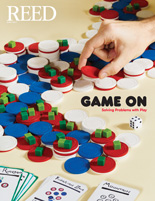
IRIS login | Reed College home Volume 96, No. 2: June 2017
Top Oregon Court Overhauls Eyewitness ID Rules

Memory expert and psychology professor Dan Reisberg found several problems with the methods investigators used to reconstruct the memory of the key witness in the case. Photo by Darryl James
The Oregon Supreme Court issued a landmark decision yesterday, proclaiming new legal standards for using eyewitness identification as evidence in criminal cases and granting a new trial to a man who was convicted of murder on the basis of an identification that the court deemed faulty.
The justices announced a unanimous ruling after reviewing thousands of pages of psychological research, including testimony from Professor Dan Reisberg [psychology 1986–], who identified several problems with the methods investigators used to identify the suspect.
“This is good news for Oregon,” Reisberg says. “I’m thrilled that the court chose to embrace the evidence and embrace the science.”
The case arose from the murder trial of Samuel Lawson, who was accused of shooting a Douglas County couple, Noris and Sherl Hilde, in an Umpqua National Forest campground in 2003. Noris was killed; Sherl survived. Later she identified Lawson as the killer, telling the jury “I’ll never forget his face as long as I live.”
Although there was no physical evidence tying Lawson to the crime, he was convicted of five counts of aggravated murder and sentenced to life in prison.
The problem is that Sherl initially said she didn’t see the killer’s face, or caught at best a fleeting glimpse of his profile. She was unable to pick Lawson out of a lineup. Only after investigators repeatedly showed her photographs of Lawson—at one point even taking her to one of his court hearings—did she begin to identify Lawson as the killer. (For a full description of the case, see the Reed magazine article, "The Darkness of Memory Lane.")
These factors did not appear to influence the trial judge or the jury, in part because Oregon's old standard for eyewitness identification, established by the court in 1979 in a case known as State v. Classen (written by Justice Hans Linde ’47) did not set out hard-and-fast rules to exclude techniques that could influence a witness' memory.
Since then, however, more than 2,000 psychological studies have been conducted into facial identification, many of them demonstrating that memories are more pliable than previously understood, and are strongly influenced by subsequent events.
“The court has clear rules for physical evidence—how it’s collected, how it’s stored, and so on—but has been more casual with witness evidence,” Reisberg says. “But witness evidence is actually more fragile than physical evidence and it needs to be treated with caution if it’s going to be truly reliable.”
The case has several other Reed connections. Lawyer Laura Graser ’73 was part of Lawson's defense team. Bronson James ’94 and Bear Wilner-Nugent ’94 both filed briefs on behalf of Lawson. Meanwhile, President John Kroger, in his former incarnation as Oregon’s attorney-general, was listed on the case caption as holding a brief for the state of Oregon.
Read the decision here.
Tags: psychology, Reisberg


LATEST COMMENTS
steve-jobs-1976 I knew Steve Jobs when he was on the second floor of Quincy. (Fall...
Utnapishtim - 2 weeks ago
Prof. Mason Drukman [political science 1964–70] This is gold, pure gold. God bless, Prof. Drukman.
puredog - 1 month ago
virginia-davis-1965 Such a good friend & compatriot in the day of Satyricon...
czarchasm - 4 months ago
John Peara Baba 1990 John died of a broken heart from losing his mom and then his...
kodachrome - 7 months ago
Carol Sawyer 1962 Who wrote this obit? I'm writing something about Carol Sawyer...
MsLaurie Pepper - 8 months ago
William W. Wissman MAT 1969 ...and THREE sisters. Sabra, the oldest, Mary, the middle, and...
riclf - 10 months ago